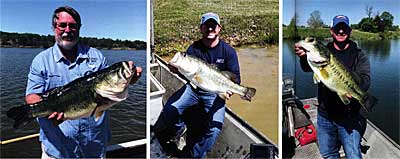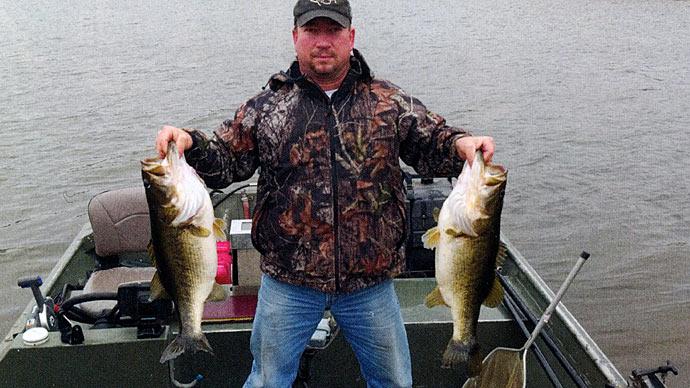
One of the most common fish questions a fisheries biologist gets is, "Should we add Florida genetics to our bass lake?" That question is posed to fisheries biologists nationwide, regardless of region.
When someone asks that pointed question, it actually means, "I want to grow the most giant bass ever, and break all the records, ever, as fast as I can."
Noble goal.
The state record bass in California stands at 22 lbs., 5 oz, caught in 1991. Heck, 20 of the top 25 biggest bass have been caught in California. All but one of those California bass were caught in lakes regularly stocked with rainbow trout. Remember that little tidbit as we go through this exercise. The Mississippi record is 18.15 lbs., caught in 1992. Alabama's record, 16 lbs. 8 oz, caught in 1987. Texas' record is 18.18 lbs., from 1992. Florida's record, from 1986, is 17 lbs., 4 oz. Heck, four states have bigger records than Florida.
Of those biggest bass, most if not all, have some level of Florida genetics. In northern tier states, like New Jersey and New York, it's assumed those bass are pure northern strain fish, but they haven't been genetically verified, so there's no proof that some bucket biologist didn't haul some fish from another source and add to that fishery mix—even if it is against the law in many states.
One of the biggest arguments against stocking Florida bass into private waters is climate. Florida strain bass no doubt grow much larger than their northern strain counterparts, but their bodies are opposed to cold water. I've watched Florida bass die in winter. I'll always remember, early in my career, shivering through a rapid moving cold front in 1983. We'd gone through Hurricane Alicia in August of that year, only to have below-freezing temperatures for more than a week all over Texas. I remember the Houston news after that front. There was more damage from that deep freeze than from the hurricane. Seems most Houston homes had their plumbing in the attic.
When temperatures don't rise above freezing for a week, and you live in Houston, prepare for another flood.
As vivid as that memory was, another was just as profound. I found a 15-pound-plus bass, floating dead in a 20-acre lake. I scooped it up, and half of its caudal fin area was eaten. I weighed it. That bass was covered in fungus, probably dead by the third or fourth day of frigid temperature. Florida-strain bass died in Texas all the way to the Rio Grande Valley.
What we figured out was Florida bass death was caused by how fast the water temperature dropped, not necessarily by how cold the water became. There are Florida genetic influenced Largemouth bass that live under ice in several states where ice occurs. Actually, my theory is Florida bass are more likely to die in states where the water temperatures can drop 20-30 degrees in a couple of days. I think that's way more significant than a specific cold-water temperature they can tolerate.
Either way, that argument influences people and their decision about whether or not to stock Florida bass. That same argument, to a lesser extent, has influenced commercial bass producers to study and select the genetically superior fish, and whether or not they should cross the different strains. Dr. Shawn McNulty, of American Sport Fish Hatchery, near Montgomery, Alabama, has his take on Florida bass genetics, cooler water, and whether or not to stock them.
"American Sport Fish, years ago, saw the value in taking superior fish of both strains, and crossing them. We did it for several reasons. First, we wanted to strive for hybrid vigor, to breed the aggressive nature of northern strain bass crossed with Florida bass' nature to grow to huge sizes." He continued, "We also saw a potential to offer these fish where climates are less conducive to pure strain Florida bass." Meaning? If someone who lives in a region subject to extreme temperature changes during fall and winter, this F1 Tiger™ bass stands a better chance to weather the storm. John Q. Pondmeister gets the best of both worlds.
Circling back to the question, "Should I add Florida bass genetics to my bass lake?"

Think a little deeper into the facts presented. Are the Florida bass in California superior to the Florida genetics of that fish's home state? Why have the state records mentioned above lasted so long? North Carolina's record of a 15 lb. 14 oz beauty from a private pond stands since 1991. Why haven't those state records been eclipsed more than once since these dates? Have those individual fish maxed out their genetic potential? Have the genetics in those lakes declined?
Before you dive into the decision to add Florida bass genetics to improve your herd, understand some crucially important facts about your fish and where they live.
When your pond or lake was built, its very best odds of growing the biggest bass on the planet was laid in the hands of those who built the lake and stocked it. Those odds were influenced by the habitat for the different species to play their roles in this quandary. After that little hurdle, it was up to the pond manager to keep the food chain in play where the best of the best bass would have all the food they needed, every day, with minimal competition from those less-than-superior siblings, cousins, and other ne'er do wells that were there just for the free semi-natural ride.
Interpretation? Half of those precious Florida bass are males, with no chance of growing to large sizes. Of the other half, maybe 25-30% of those girls have the propensity and aggressive nature to grow to truly huge sizes, given the opportunity and not being immediately consumed by opportunistic creatures in that habitat. You can see by these numbers that stocking bass fingerlings into an existing fishery is a roll of the dice. As long as you know the odds, roll them.
I talked with Allen Forshage, who is recently retired from the Texas Parks and Wildlife Department. He ran the Texas Freshwater Fisheries Center in Athens, and was instrumental and involved with the stocking of Florida bass all over Texas, from Lake Fork to other public lakes to establish the strain. He said, "You've got your best chance at growing trophy bass from the first stocking. Over time, habitat degradation influences trophy bass production." Take Lake Fork, for example. Fish from that reservoir have made it famous for giant bass. When asked why the record has stood so long, he said, "Way too many trophy quality bass were mishandled and removed from that lake during its prime, coupled with habitat degrading, it has become what it is. It's still a great fishery."
If you've originally stocked Florida bass in your lake, feed them. Make sure competition is managed. That means selective culling. The reason you don't have trophy bass isn't likely an issue of genetics. It's more about the environment, especially habitat and plentiful food, full time.
Dave Terre, recently retired Florida bass expert with the Texas Parks and Wildlife Department, studied the fish for decades. "Our original goal was to make sure at least 20% of bass sampled had Florida alleles. If not, we'd stock more Florida bass. Over years, we achieved that, and now we stock more Florida bass into lakes that have proven they can grow trophies."
Their process is different now, and similar to advice given to private pond owners. If you stock more Florida or F1 bass into your existing lake, your odds of some of them growing into trophies goes up, especially if those fingerlings come from giant bass parents. But those odds are influenced tremendously by habitat and existing predation...and food, lots of food. In other words, if you stock baby bass where there are already baby bass or medium-sized bass, or big bluegills, or crowded bass, don't expect your newly stocked princesses to make it to queens. Set the stage, set the table, and then add new royalty.
Keeping in mind most lakes grow their best bass from their original stockings, and your lake didn't keep pace for whatever reasons, you can change it. Decrease competition, increase the food, take better care of your biggest bass, and keep the food chain propped up—all the time. Selective culling is important, but not like what apparently happened with Lake Fork. If you cull the junior varsity, time will take its toll on your championship lake. When the wrong fish are harvested and the food chain is depleted as habitat degrades, a lake will become what it's destined to be instead of what you want it to be.
McNulty sees things a little differently. "We've seen some great things from the Fl's. We also tell people to be ready to cull fish, especially during or after the third year. That's when bass tend to become crowded. When people stock F1 bass, and they grow up, they cannot produce offspring the same as they are. It's genetically impossible. In order to keep the Fl's recruiting, you need to stock more every two to four years."
That means we don't count on F1 bass to keep the trophies coming beyond that first stocking of that gene pool. That means we need to stock more bass. But McNulty has a qualifying statement. "If you want to add more bass, be sure to cull as many of your overcrowded existing bass as possible before stocking more bass."
Do you want to stock some pure strain Florida bass? That can be a good idea, as long as you have the habitat and food chain to support those fish. Don't put them in a bass-crowded lake and expect much. Don't count on your existing Florida bass to have everything it takes to grow huge. If an inferior Florida male spawns with and inferior Florida female, your odds of big fish aren't so big.
If you want to grow some truly huge bass, of course genetics play a huge role. Can't do it without those genetics. But, if your Florida bass aren't growing to the sizes you think they should, stocking more Florida bass may not make a difference.
Forshage had the best summary. "We've contracted with some private landowners in Texas over the years and have grown some huge bass. But it was because forage fish was plentiful."
If you stock genetically superior bass, budget time and money to make sure they have the best food chain, all the time, for the target size bass you want to grow. As long as you are doing that, staying on top of your growth rates and culling the under-performers, recruiting the next line of trophies via stocking can be a good idea.
Reprinted with permission from Pond Boss Magazine



